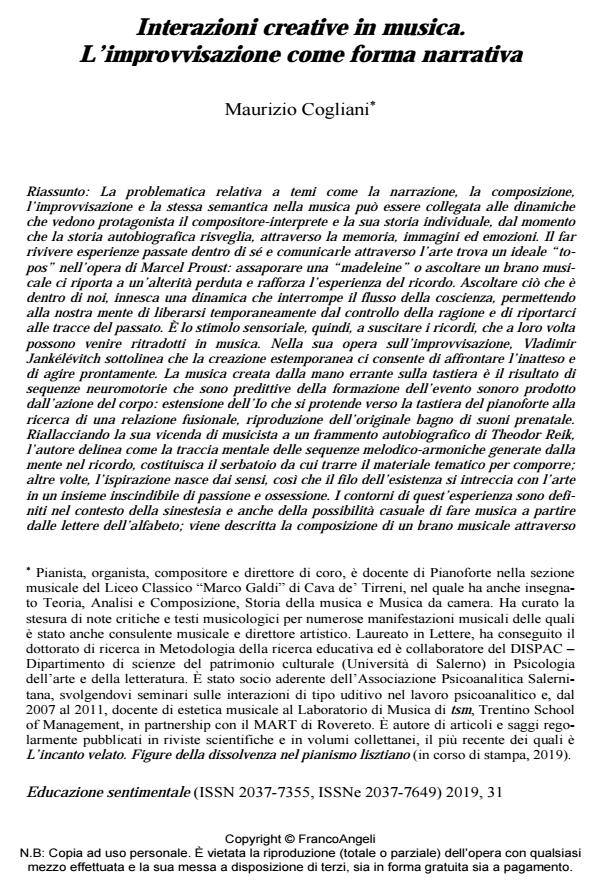Interazioni creative in musica. L’improvvisazione come forma narrativa
Journal title EDUCAZIONE SENTIMENTALE
Author/s Maurizio Cogliani
Publishing Year 2019 Issue 2019/31
Language Italian Pages 19 P. 84-102 File size 361 KB
DOI 10.3280/EDS2019-031007
DOI is like a bar code for intellectual property: to have more infomation
click here
Below, you can see the article first page
If you want to buy this article in PDF format, you can do it, following the instructions to buy download credits

FrancoAngeli is member of Publishers International Linking Association, Inc (PILA), a not-for-profit association which run the CrossRef service enabling links to and from online scholarly content.
Creative interactions in music: Improvisation as a narrative form. The issue related to themes such as narration, composition, improvisation and the semantics itself in music can be con-nected to dynamics that see the composer-interpreter and his individual history as a protago-nist, since the autobiographical story awakens, through the memory, images and emotions. To revive past experiences within oneself and to communicate them through art finds an ideal "topos" in Marcel Proust’s work: savoring a "madeleine" or listening to a piece of music brings us back to a lost otherness and reinforces the experience of remembrance. Listening to what is inside us, triggers a dynamic that interrupts the stream of consciousness, allowing our mind to temporarily free itself from the control of reason and to lead us back to traces of the past. It is the sensorial stimulus, therefore, to arouse memories, which in turn can be re-translated into music. In his work on improvisation, Vladimir Jankélévitch emphasizes that the extemporaneous creation allows us to face the unexpected and to act promptly. The music created by the wandering hand on the keyboard is the result of neuromotor sequences that are predictive of the formation of the sound event produced by the action of the body: exten-sion of the ego reaching out towards the piano keyboard in search of a fusional relationship, reproduction of the original prenatal sound bath. Reconnecting his story as a musician to an autobiographical fragment by Theodor Reik, the author outlines how the mental trace of the melodic-harmonic sequences generated by the mind in memory constitutes the reservoir from which he draws the thematic material to compose; at other times, inspi-ration is born of the senses, so that the thread of existence is interwoven with art in an inseparable whole of pas-sion and obsession. The contours of this experience are defined in the context of synaesthesia and also of the chance to make music starting from the letters of the alphabet; the composi-tion of a musical piece through this particular creative typology is described. Finally, an at-tempt is made to give a frame of reference to the experiences that start from the narration of oneself to reach musical performance in front of an audience. In the context of the psychoana-lytic interpretation of the art by Ignacio Matte Blanco, the artwork appears as a bi-logical structure that is simultaneously expression of symmetry and asymmetry. In conclusion, in this framework it is possible to codify the story of oneself through an emotionally oriented musical operation, based on improvisation/composition as an interpretative model of internal and external reality.
Keywords: Creativity, improvisation, composition, narration, Self, memory, randomness, synaesthesia, emotion, obsession, bi-logic, unfolding
Maurizio Cogliani, Interazioni creative in musica. L’improvvisazione come forma narrativa in "EDUCAZIONE SENTIMENTALE" 31/2019, pp 84-102, DOI: 10.3280/EDS2019-031007